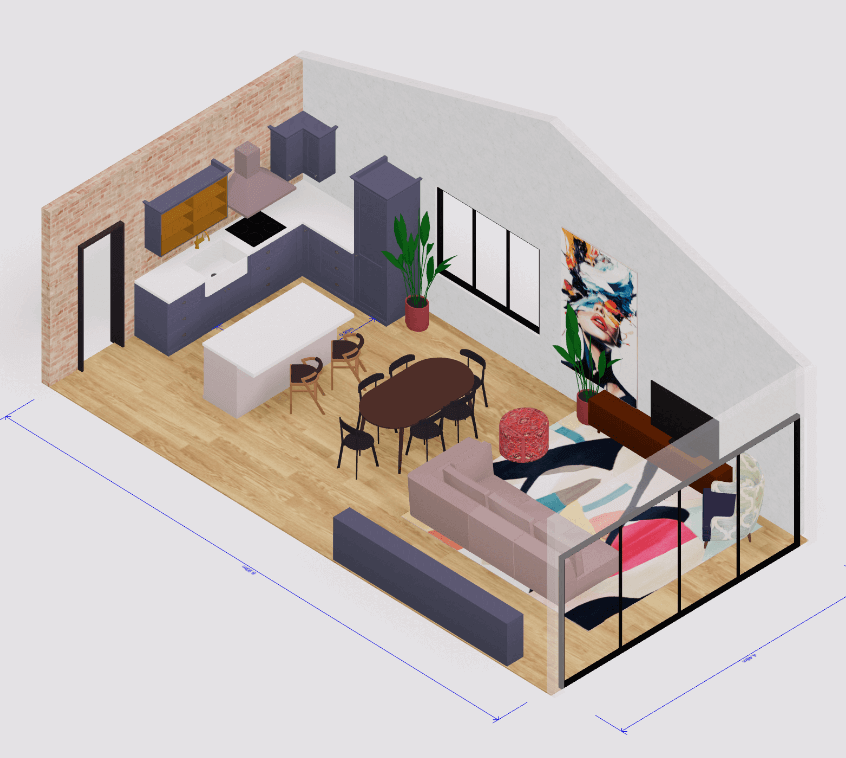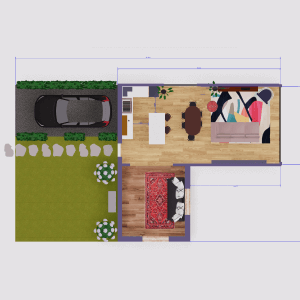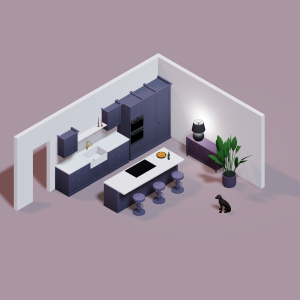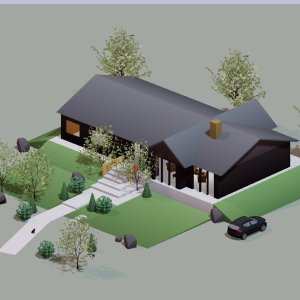To get started with 3D modeling software for home design, users must select appropriate software. Criteria include user-friendliness, feature richness, and budget suitability. Examples, SketchUp and Blender, offer comprehensive toolsets for beginners and professionals. Data show SketchUp features an intuitive interface, while Blender excels in versatility for complex designs. Users need to invest in learning resources. Tutorials, forums, and online courses support skill development. Websites like Udemy and Coursera host courses tailored to various software, aiding users in mastering 3D modeling techniques.
Arcadium 3D streamlines the design process, targeting interior designers and enthusiasts who prioritize speed and simplicity. SketchUp and Blender require more time to learn due to their broad feature sets. Arcadium 3D stands out for its user-centric approach, enabling the creation of 3D house plans within minutes without overwhelming users with complex tools. This focus on efficiency and accessibility makes Arcadium 3D an attractive option for those seeking to quickly bring their home design visions to life.
Contents:
Understanding 3D Modeling Software Basics
What defines 3D modeling software at its core? Essentially, these are tools designed for creating, manipulating, and viewing objects in a three-dimensional space. Users engage with interfaces that allow them to simulate real-world entities, such as buildings and furniture. This digital environment supports architects in visualizing spatial arrangements and assessing designs before actual construction begins.
Why are features like texture mapping and lighting controls vital? They imbue models with realism and detail, transforming simple shapes into lifelike representations. Lighting effects mimic natural light and shadows, offering a glimpse of how objects and spaces appear at different times of the day. Texture mapping wraps surfaces with images to simulate materials like wood, stone, or fabric, thus enhancing the visual richness of models.
How does one navigate the complexity of software tools? By starting with basic functions and gradually exploring more advanced features, users can avoid feeling overwhelmed. Tutorials and online courses serve as valuable resources for mastering techniques such as extrusion, which extends a shape into a 3D form, and Boolean operations that combine or subtract shapes to create complex geometries. Engaging with community forums also facilitates knowledge exchange and problem-solving.
In understanding 3D modeling software basics, ease of learning stands as a major advantage for beginners over the intricacy of advanced features, which cater to experienced users. Mastery of simple tasks builds a foundation, enabling a seamless transition to more sophisticated operations. Thus, early focus on comprehending basic functionalities fosters quicker adaptation and proficiency, significantly enriching the user's design capability and creative expression.
What factors should you consider when selecting a 3D modeling tool for home design? Compatibility and ease of use rank high. Programs that support various file formats enable smoother workflow transitions between different stages of design, from conceptual sketches to detailed plans. Ease of use ensures a steep learning curve becomes a gentle incline, making advanced features accessible to beginners and professionals alike.
How do the software's features align with your project needs? Comprehensive feature sets distinguish one tool from another. High-quality rendering capabilities, extensive libraries of objects and materials, and intuitive user interfaces define superior tools. These features simplify the process of bringing visions to life, turning complex designs into manageable projects.
Why is community support and software updates important? Continuous improvement and problem-solving stand as pillars of a reliable tool. A vibrant community offers a wealth of shared knowledge and troubleshooting advice, while regular updates ensure compatibility with new technologies and enhance functionality. This dual support system maintains the software's relevance and utility over time.
Software A, with its intuitive interface, accelerates the learning process more effectively than Software B, which may offer a broader range of features but lacks simplicity. The former boasts a supportive community that eagerly shares tips and tricks, unlike the latter's more insular user base. Software A's frequent updates introduce cutting-edge features without sacrificing stability, while Software B's updates occur less frequently, potentially leaving users behind current standards.
Mastering Key Features for Effective Home Design
What are the foundational tools necessary for proficiently navigating 3D modeling software? Understanding the user interface and command shortcuts accelerates the modeling process. Efficient utilization of these tools enhances workflow, ensuring projects progress swiftly without unnecessary delays.
How crucial are lighting and texturing techniques for bringing designs to life? These elements are paramount, turning flat, lifeless models into vivid, realistic simulations. Mastery over lighting shadows, hues, and intensity, alongside texture application–ranging from rough surfaces like brick to smooth finishes such as marble–gives depth to the visual presentation, mimicking real-world scenarios accurately.
Why should one focus on learning advanced features like parametric modeling and Boolean operations? These sophisticated functions allow for the creation of more complex and customizable designs. Parametric modeling facilitates the adjustment of dimensions and relationships between objects dynamically, whereas Boolean operations enable the combination or subtraction of shapes to craft intricate models, thereby expanding creative possibilities significantly.
Proficiently mastering key features in 3D modeling software yields greater efficiency and quality in home design than relying on basic functions alone. Users who invest time in understanding advanced techniques find themselves completing projects with higher precision and creativity, as opposed to those who limit themselves to elementary tools. This advanced knowledge permits the exploration of innovative design solutions, pushing the boundaries of conventional home design.
What is the first step for a beginner eager to bring their home design visions to life through 3D modeling software? Selecting the appropriate software tailored to novice users is crucial. Numerous options cater specifically to those with minimal experience, offering user-friendly interfaces and straightforward tools. Such programs often include tutorials, templates, and drag-and-drop features, facilitating a smooth learning curve.
How can one efficiently transfer their rough sketches or vague mental images into a digital format? By breaking down the project into smaller, manageable segments. Start with outlining the basic structure, such as walls and floors, before gradually adding more complex elements like furniture and lighting. This method ensures attention to detail and fosters a comprehensive understanding of spatial relationships within the design.
Why is it important to engage with the community and seek feedback on early designs? Interaction with fellow beginners and more experienced users alike promotes learning through constructive criticism and exchange of ideas. Many forums and online groups offer a platform for sharing projects and receiving suggestions, which can highlight unseen errors and introduce new techniques or tools that could enhance the design further.
In terms of learning and mastering 3D modeling for home design, starting with software designed for beginners proves significantly more beneficial than tackling advanced programs. Beginners' software not only shortens the learning period but also reduces frustration, increasing the likelihood of persistence and success in digital design endeavors. On the other hand, advanced software, while offering more sophisticated features, typically assumes a level of expertise that can overwhelm novices, potentially stifling creativity and progress.
From Concept to Creation: Designing Your First Home
Where do ideas for home design originate? Ideas often stem from personal preferences, lifestyle needs, and inspiration from various sources such as nature, architecture, and even movies. Architects draw influence from their surroundings, while interior designers may look to current trends for guidance. These initial sparks fuel the creative process, leading to the conceptualization of a unique space.
How does one transfer these concepts into tangible plans? Utilizing 3D modeling software stands out as an effective method. This technology allows users to construct detailed models of their envisioned home, providing a clear visual representation. Designers utilize tools within the software to sculpt, texture, and color each element of the home, from spacious living rooms to compact bathrooms, ensuring every detail aligns with the homeowner's vision.
What challenges might beginners face when navigating 3D modeling software? The complexity of the software can be daunting at first, with an array of tools and features to master. However, tutorials and online courses offer step-by-step guidance, helping novices learn the basics of modeling, texturing, and rendering. These resources demystify the process, enabling even those with no prior experience to create detailed home designs.
In creating a home from concept to creation, the precision and flexibility of 3D modeling software significantly outshine traditional drawing methods. Designers can easily adjust dimensions, experiment with different materials, and visualize the impact of lighting on spaces, ensuring the final design is both functional and aesthetically pleasing. This approach not only streamlines the design process but also enhances collaboration between designers and homeowners, as changes can be made in real-time and reviewed instantly.
Avoiding Common Pitfalls in 3D Home Design
Why do many struggle with 3D home design initially? A common reason is overlooking the scale and proportions. Users often misjudge the size of rooms and furniture, leading to unrealistic designs. Architects ensure measurements are precise; hobbyists frequently estimate, resulting in errors.
How can one avoid the temptation of overcomplication? By embracing simplicity. New designers tend to add too many elements, making spaces feel cluttered. Experts recommend starting with basic shapes; novices often jump to complex structures. This approach keeps designs clean and manageable.
What is a frequent oversight in 3D modeling for home design? Ignoring the importance of lighting and textures. Proper lighting can transform a space, making it feel warm and inviting. Designers focus on daylight and artificial sources; beginners might neglect this aspect. Similarly, selecting appropriate textures brings realism to models; this step is sometimes underestimated.
In terms of learning curve, mastering 3D modeling software is more challenging than traditional drawing methods. However, the former offers unparalleled precision in visualizing and modifying designs. Traditional methods require manual adjustments for each revision, while digital tools allow instant updates. This efficiency makes overcoming initial hurdles in 3D modeling worthwhile, especially when aiming to sidestep common design pitfalls.
Keeping Your Home Design Projects Organized
How does one ensure the organization of their home design projects? The key lies in leveraging the capabilities of the software. Users can create folders for each project, which allows for easy access and categorization. Architects often divide these projects into phases such as planning, design, and execution, ensuring a streamlined workflow.
What tools within the software assist in project organization? Features such as tagging and color-coding prove invaluable. These elements enable designers to quickly identify different components of a project, like rooms or materials, simplifying the search process. Engineers frequently utilize these tools to differentiate between structural elements, electrical layouts, and plumbing schematics, facilitating a comprehensive overview.
Why is consistent file naming important? It ensures efficiency and reduces confusion. Adopting a uniform naming convention across all projects aids in the quick retrieval of files. Interior designers, for instance, might adopt a naming system based on room type followed by design aspect, such as "Kitchen-Cabinetry" or "LivingRoom-FurnitureLayout." This method proves especially beneficial for teams, allowing for seamless collaboration and file sharing.
Organizing home design projects with 3D modeling software significantly enhances productivity over traditional methods. Digital tools streamline the process of locating files, updating designs, and collaborating with team members. Where manual organization methods are time-consuming and prone to error, digital organization excels in speed and accuracy. The difference in project management efficiency is stark, with digital organization reducing the time spent searching for files and increasing the time available for creative design work.
Exploring Advanced Techniques in 3D Modeling
How can advanced techniques elevate your 3D modeling projects? Incorporating techniques such as texture mapping and Boolean operations can significantly enhance realism and complexity. Texture mapping allows the addition of details like wood grain or stone textures to surfaces, making them appear more lifelike. Boolean operations enable the combination or subtraction of shapes to create intricate models, such as gears or intricate furniture pieces.
What benefits do lighting and shadows offer in 3D modeling? These elements introduce depth and perspective, vital for a realistic representation. Proper lighting can highlight textures and forms, simulating different times of the day or artificial light sources. Shadows add volume and grounding, making objects appear integrated into their environments rather than floating in space.
Why is it important to explore particle systems and physics simulations? These advanced techniques can simulate natural phenomena, such as water flow or smoke, adding a layer of dynamism and realism to models. Particle systems can create complex effects such as rain, fire, or foliage, enriching the environment. Physics simulations ensure that objects behave in accordance with real-world laws, such as gravity and collision, enhancing the viewer's immersion.
Exploring advanced techniques in 3D modeling introduces a layer of sophistication and detail unachievable with basic models. Techniques like texture mapping and Boolean operations add depth and complexity, making models more lifelike. Lighting and shadows further enhance realism by introducing perspective and volume. Particle systems and physics simulations infuse models with dynamic elements and real-world behaviors, elevating the overall visual experience to new heights.


 All training, tips and articles
All training, tips and articles
 3D house design tool
3D house design tool

 Color palette generator
Color palette generator
 Floor plan creator
Floor plan creator
 Interior design app
Interior design app
 Kitchen design tool
Kitchen design tool
 House design software
House design software
 Room designer
Room designer
 Landscape design software
Landscape design software
 Bedroom design
Bedroom design
 Office floor plan creator
Office floor plan creator




